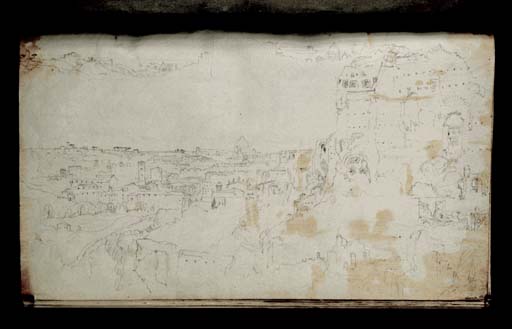Joseph Mallord William Turner Six Sketches of Views from the Palatine Hill, Rome 1819
Image 1 of 2
Joseph Mallord William Turner,
Six Sketches of Views from the Palatine Hill, Rome
1819
Joseph Mallord William Turner 1775–1851
Folio 55 Verso:
Six Sketches of Views from the Palatine Hill, Rome 1819
D16386
Turner Bequest CLXXXIX 55 a
Turner Bequest CLXXXIX 55 a
Pencil on white wove paper, 229 x 368 mm
Inscribed by the artist in pencil ‘Arch of Janus’ centre of sketch and ‘[?wood]’ bottom centre of sketch, top left
Inscribed by an unknown hand in pencil ‘clxxxix 55a’
Inscribed by the artist in pencil ‘Arch of Janus’ centre of sketch and ‘[?wood]’ bottom centre of sketch, top left
Inscribed by an unknown hand in pencil ‘clxxxix 55a’
Accepted by the nation as part of the Turner Bequest 1856
References
1909
A.J. Finberg, A Complete Inventory of the Drawings of the Turner Bequest, London 1909, vol.I, p.564, as ‘Rome, from the Esquiline Hill, with “Arch of Titus” in mid-distance and St. Peter’s beyond. Pencil, on white side of paper.’.
1984
Cecilia Powell, ‘Turner on Classic Ground: His Visits to Central and Southern Italy and Related Paintings and Drawings’, unpublished Ph.D thesis, Courtauld Institute of Art, University of London 1984, p.427, as ‘Rome from the Palatine with Arch of Janus in mid-distance’.
The Palatine Hill was one of the most popular vantage points in Rome and Turner made a large number of studies from the location, recording prospects of the city seen in all directions. The main sketch on this page depicts a view from the southern side of the hill looking west. The right-hand foreground is dominated by part of the crumbling exedra of the Hippodromus Palatii, from the Domus Augustana (part of the Palace of Domitian), and the vista opens out to a view across the River Tiber and Trastevere on the left. Visible landmarks include, from left to right: part of the Circus Maximus in the bottom left-hand corner; the churches of Trastevere including the pointed bell-tower of San Crisogono; the Janiculum Hill crowned by trees; in the middle distance, the Romanesque bell-tower of Santa Maria in Cosmedin; the Isola Tiberina and Ponte Sisto (with its central occulus); the buildings of the Forum Boarium, including the circular Temple of Hercules Victor; and the Church of Sant’Anastasia with its decorative posts adorning the roof. To the immediate right of the church, Turner has also noted the location of the ‘Arch of Janus’, a four-sided triumphal arch which stands in the Forum Boarium near the Church of San Giorgio in Velabro. Rising in the distance above the rest of the city is the unmistakeable silhouette of the dome of St Peter’s.
In addition to the large view described above, there are five other smaller studies on this page of ruins and vistas of the Palatine Hill. These include, in the bottom right-hand corner, a repetition of the view looking towards St Peter’s and, in the top left-hand corner, the view looking south towards the Aventine Hill and the Pyramid of Cestius. Further related sketches can be found on another sheet within this sketchbook (see D40050; verso of Turner Bequest CLXXXIX 42), in the Small Roman C. Studies sketchbook (see Tate D16418–D16419; Turner Bequest CXC 16a–17), and in the Albano, Nemi, Rome sketchbook (see Tate D15392–D15393 and D15440–D15441; Turner Bequest CLXXXII 50a–1 and 74a–5). The depicted panoramas are also similar to those in two drawings by James Hakewill, both titled Rome, Ruins of the Palace of the Caesars on the Palatine Hill 1817 (British School at Rome), which Turner would almost certainly have known from collaborating with the artist on Hakewill’s Picturesque Views of Italy in 1818–19.1
The paper on this page has suffered from some discolouration.
Nicola Moorby
October 2009
How to cite
Nicola Moorby, ‘Six Sketches of Views from the Palatine Hill, Rome 1819 by Joseph Mallord William Turner’, catalogue entry, October 2009, in David Blayney Brown (ed.), J.M.W. Turner: Sketchbooks, Drawings and Watercolours, Tate Research Publication, December 2012, https://www


